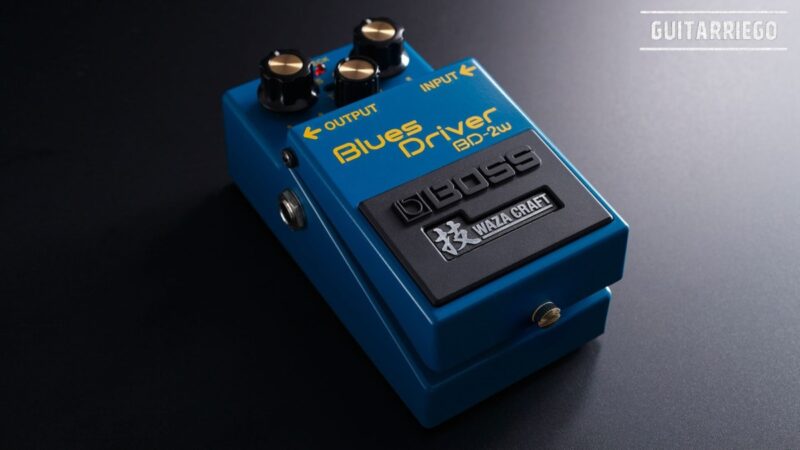Ukulele chords, ultimate guide for beginners
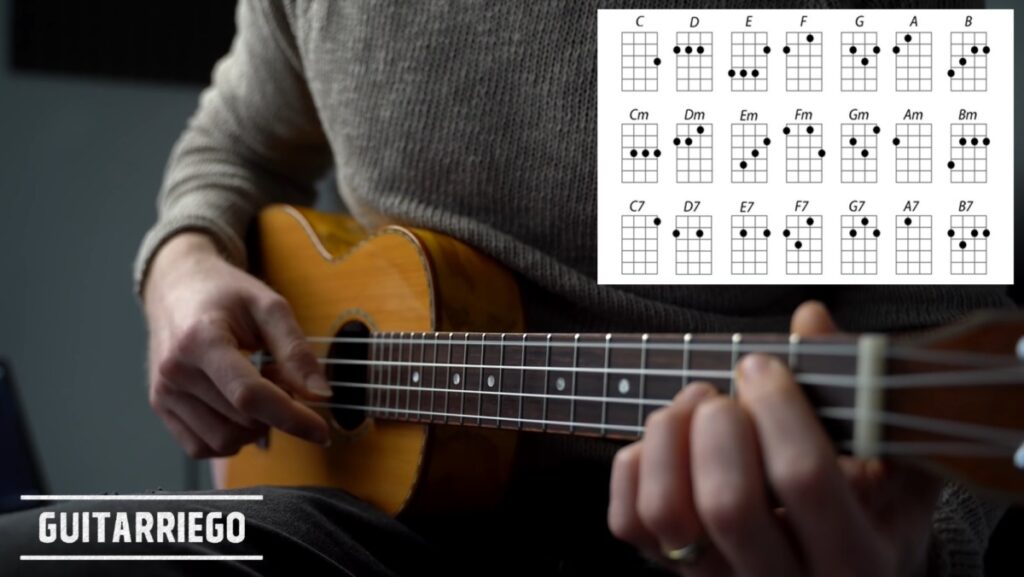
Ultimate guide on Ukulele chords for beginners, with characteristics, charts and intervals of the major, minor, maj7 and 7th chords.
Learn Ukulele chords
The cheerful and sparkling sound, the ease of playing, transportability and low cost of a ukulele have made this instrument popular. Both young and old people have discovered the wonderful world of the ukulele.
One of the first steps a beginner ukulele player should take is learning the chords on the ukulele. Not only which strings to play and on which fret, but also, with which fingers to finger each string. Once you learn how to play chords on the ukulele plus easy strumming, you’ll be able to bring those happy, melodious tones of a ukulele to life and play the songs you love.
Visit our selection of the best easy ukulele songs for beginners.
Reasons to learn to play uke chords
Beyond the joyous sound of this beautiful musical instrument, there are other important reasons to learn to play the ukulele. Thus, we summarize the reasons for you to learn to play ukulele chords.
- The uke has a lively and vibrant sound, with which you can interpret any popular song.
- The ukulele is a very friendly instrument, that is, easy to play thanks to its dimensions, weight, and its only four soft nylon strings.
- It is an inexpensive instrument, often worth up to a fifth of the value of other musical instruments.
- The uke is small and light, easy to transport, so you can take it on a trip or wherever you want.
Do you need something else to learn some ukulele chords for beginners and expand your knowledge of this cool musical instrument?
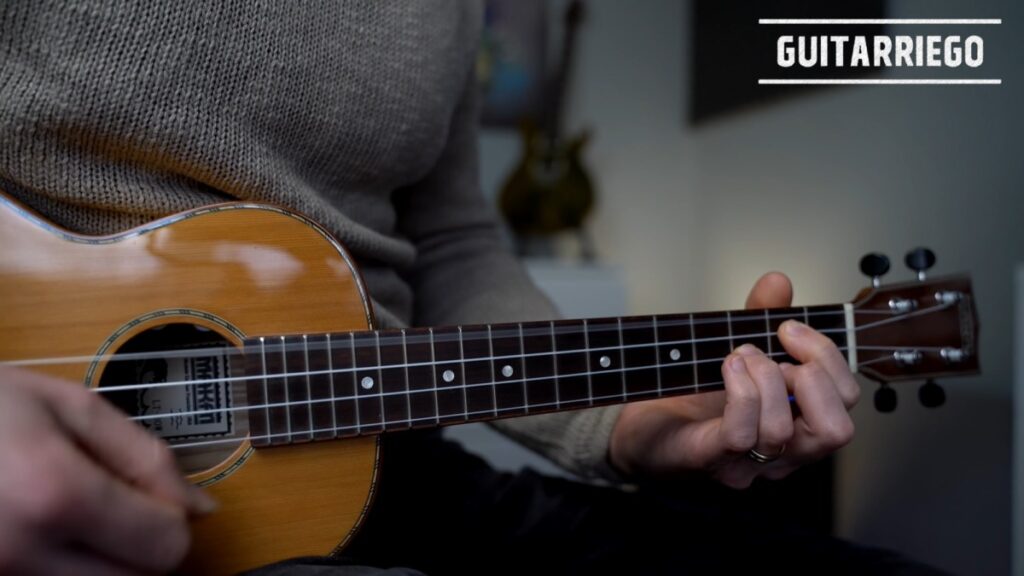
What is a ukulele chord?
A ukulele chord is the combination of three or more notes that have a certain relationship to each other and produce a pleasing harmony when played together. Thus, a basic chord is made up of:
- the root of the uke chord (1st note),
- the third note counting from the first note following the musical scale -this defines if the chord is major or minor-,
- and the fifth note of the scale counting from the 1st. note -the root of the ukulele chord-.
There can also be more notes, and these will define if it is a 7th, 9th, etc. chord.
Thus, chords are the basic elements with which songs are built, which are formed using musical scales.
How long does it take to learn ukulele chords?
Learning to play all the ukulele chords can take a long time, especially if you are new to plucked string instruments. But luckily, with four very easy to play ukulele chords you can learn a lot of popular songs. These uke chords are C Major or just C, A minor (Am), F and G.
Learning to play C, Am and F literally takes a few minutes. In the case of G you may have to invest a little more than a few minutes, but it is still an easy ukulele chord to learn.
Thus, by practicing just a few minutes a day, with short lessons, you can learn to play ukulele chords and songs. It really is easy and fun to learn ukulele chords and progress to the uke chord progressions heard in songs.
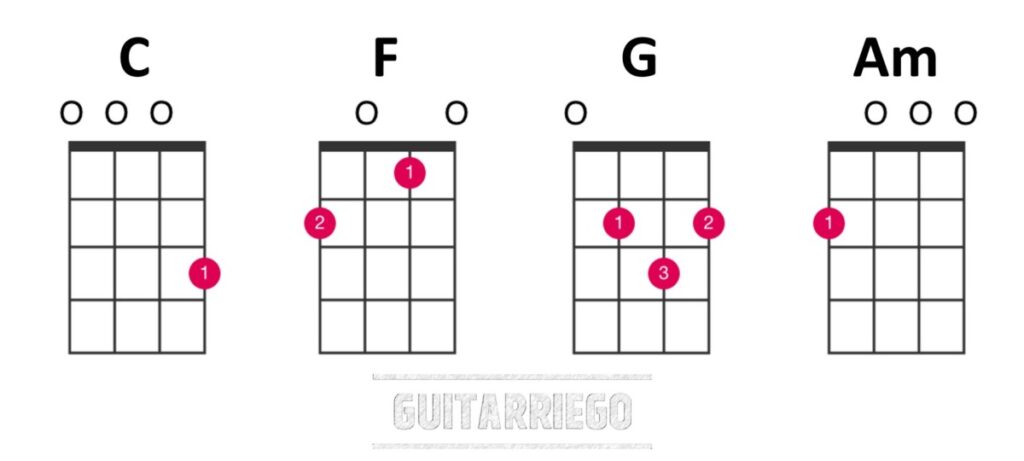
Tips for learning to play Uke chords
By following these simple tips, you will learn to play chords on the ukulele very quickly:
- Support the strings with the tips of your fingers so that your fingers are almost perpendicular to the fingerboard of the ukulele.
- Identify with which finger you should play each string, normally you will be indicated with finger 1, which you should support the index finger, 2 for the major finger, and so on.
- Once your fingers are placed on the fingerboard of your ukulele, test that each of the strings sounds correctly. That is, play the strings one by one, in a strum you can overlook that a string does not sound as it should.
- Then, practice the transitions between ukulele chords, for this we recommend that if necessary, start a moment before in the assembly of the chord to make it sound on time, without losing the tempo of the song.
- Next, learn and practice ukulele strumming to give your chords rhythm and dynamics.
- Always review and memorize each step well before moving on to the next.
We recommend that you visit our tutorial on the parts of a Ukulele.
How to Read Ukulele Chord Diagrams
Ukulele chord diagrams consist of a visual representation of the fretboard with the strings, frets, and nut, and dots or circles with internal numbers indicating where and with which finger to finger. Thus, it is key to learn to read the ukulele chord charts.
The thickest and horizontal line at the top is the representation of the nut of the musical instrument. The four vertical lines are the uke strings. Finally, the thinner horizontal lines below the nut are the frets of the ukulele.
It is important that by now you know the names of the strings and what note they sound whens when you play open each string:
- The fourth string, which is the second highest, is a G
- The third string, which is the lowest tone, is a C
- The second string is an E
- The first string, which is the thinner and highest pitch, is an A

Reentrant tuning and linear tuning
If you have ever played a plucked instrument, you will be surprised by the arrangement of the ukulele strings. The ukulele has reentrant tuning, that is, the tuning is not arranged in ascending or descending order, as it happens in the guitar and bass.
Thus, the ascending or descending linear tuning is one where the strings are tuned in order of tonality, from the highest to the lowest or vice versa. In its standard tuning the ukulele is tuned in reentrant tuning, so the lowest pitched string on a ukulele is actually the third string. However, there is the option of putting a fourth Low G string, instead of the High G, and tuning the ukulele with linear tuning.
Use our free online tuner to tune your ukulele, guitar or bass.
Fingers and their identification
Also, you have to know how to identify numbers and symbols on ukulele chord charts that show you where to place each finger to play the chord correctly.
- O: A circle above the string means playing that string in an open position.
- X : A cross or “X” above the strings means that this string will not be played or muted when played
- 1 : index finger
- 2 : middle finger
- 3 : ring finger
- 4 : little finger or pinkie

Ukulele Chord Chart Examples
Below you will find two example chord charts for uke, the one for G major and F major.
Open G Major Chord on Ukulele
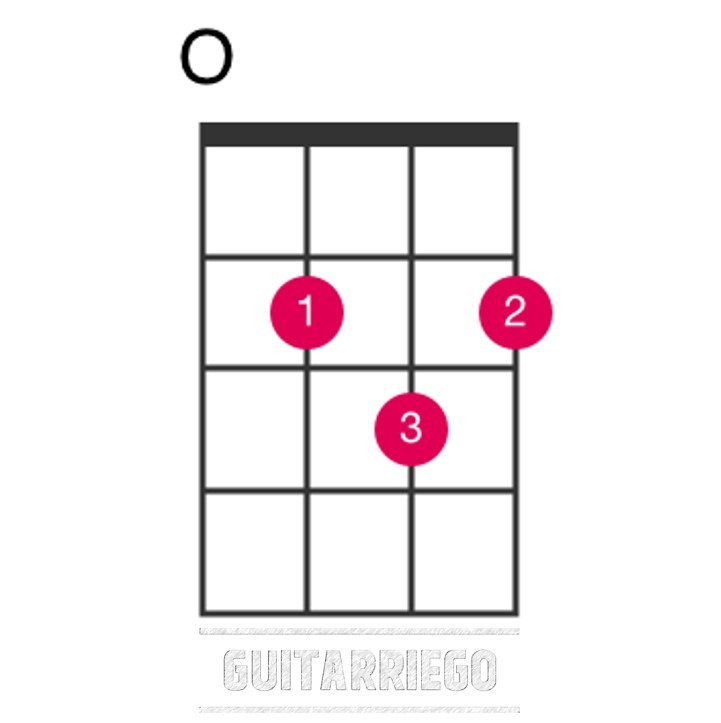
Above the G Major chord chart indicates that:
- With your index finger -number 1- you must play on string 3, on fret 2 of the ukulele.
- With your middle finger -number 2- you must play on string 1, on fret 2 of the ukulele.
- With your ring finger -number 3- you must play on string 2, on fret 3 of the ukulele.
That way, you build the G major chord on the ukulele.
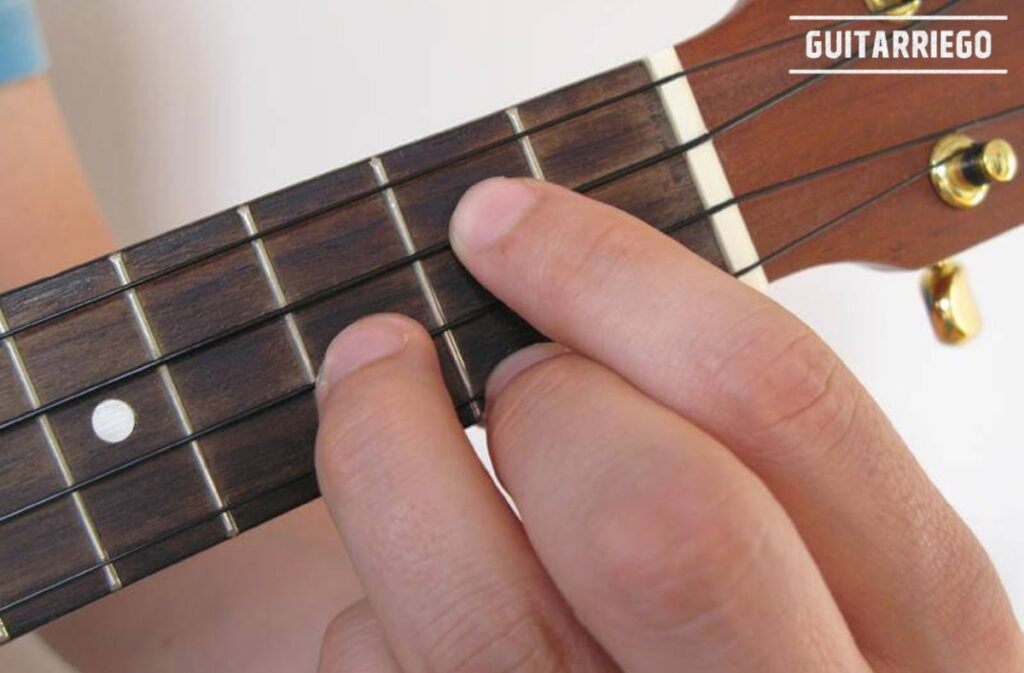
F Major chord on the Ukulele
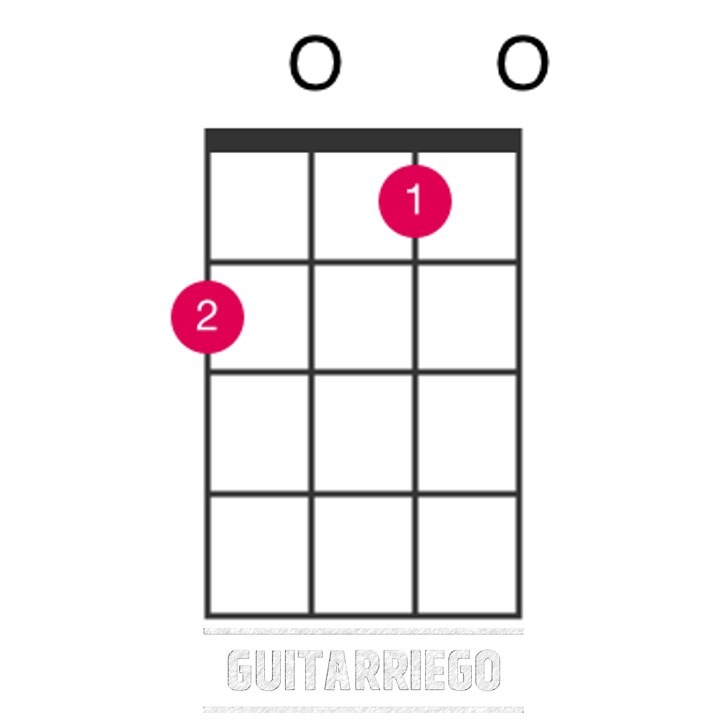
Above the F major chord chart indicates that:
- With your index finger -number 1- you must play on string 2, on fret 1 of the ukulele.
- With your middle finger -number 2- you must play on string 4, on fret 2 of the ukulele.
That way, you have the F major chord on the ukulele.
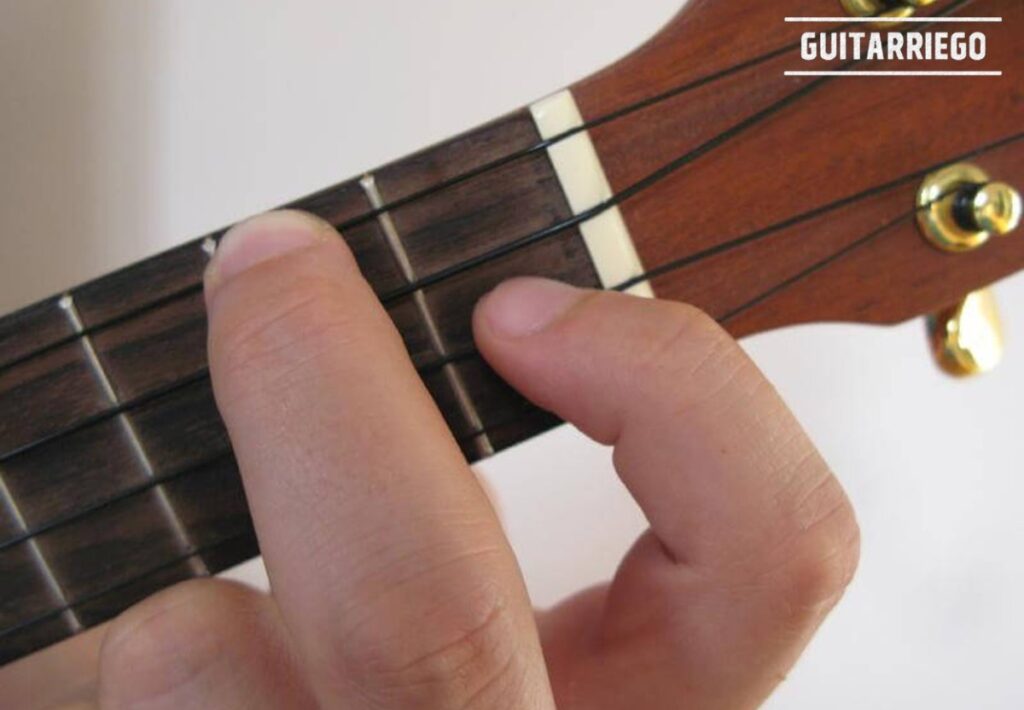
We recommend that you use our free online metronome for ukulele, guitar and bass when studying and practicing chords.
Types of Ukulele chords
There are several types of ukulele chords, the most used are the major, minor and to a lesser extent the seventh chords. These three types of chords have their own harmonic characteristics. In a very quick description we can say that the major chord is a happy chord, the minor chord is more melancholic and the seventh chord is a stressed chord that usually asks for a resolution in another chord. Thus these types of ukulele chords have their own mood and sound when played as a single chord, or create the feel of a song when different chords are played as part of a chord progression in a song.
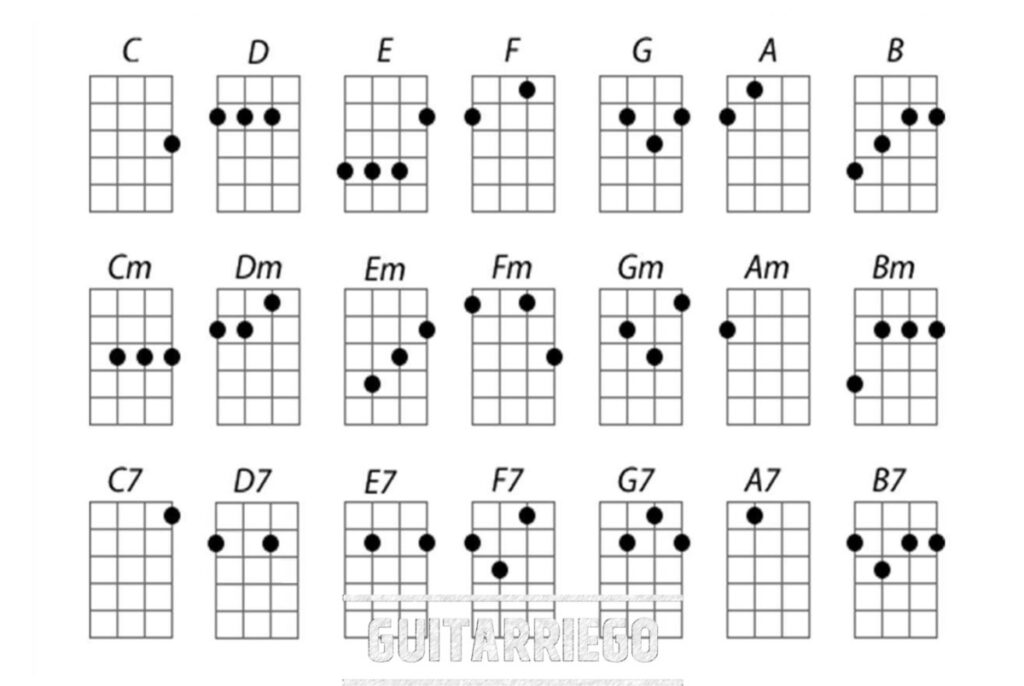
What is a Ukulele Major Chord?
The major chord is characterized by having a happy and harmonic sound, without tension. Major chords are made up of the root note (the first), the third note, and the fifth note of a given major scale counting from the first note. Thus, for a chord to be major, the distance between the first and third notes must be 2 tones or 4 semitones. Lastly, the third note of a major chord is the perfect fifth, which is 3 1/2 tones or 7 semitones from the first note. Just so you know, between two consecutive ukulele frets there is a semitone distance.

This is how all major chords are formed, with the root note, the major third, and the perfect fifth.
What is a Ukulele minor chord?
While the major chord has a happy tone, the minor chord has a melancholic or sad tone, but it also sounds harmonious, without tension.
Minor chords are made up of the root note (the first), a third note, and a fifth note of a given minor scale. Thus, for a chord to be minor, the distance between the first and third notes must be 1 1/2 tones or 3 semitones. Lastly, the third note of a minor chord is the perfect fifth, which is 3 1/2 tones or 7 semitones from the first note. Remember that between two consecutive frets of the ukulele there is a semitone distance.

This is how all minor chords are formed, with the root note, the minor third, and the perfect fifth.
If you want to know the music theory behind chords, don’t miss our lesson on the 7 Greek modes and how chords are formed.
What is a ukulele seventh chord?
A seventh chord or tetrad is a chord that consists of a triad, like the ones we saw above, plus a note that forms a seventh interval above the root of the chord. These chords are characterized by generating a tension that requires resolution in another chord located 2 1/2 tones or 5 tones above.
When not otherwise specified, a “seventh chord” such as C7, generally means a dominant seventh chord that is a major triad together with a minor seventh. However, different types of triads can also be combined with a minor, major or diminished seventh. Thus we will find five different types of seventh chords:
- Dominant seventh (C7): Major triad with a minor seventh (major 3rd, perfect 5th, and minor 7th above the root note of the chord)
- Major seventh (Cmaj7): Major triad with a major seventh (major 3rd, perfect 5th, and major 7th above the chord root)
- Minor seventh (Cm7): Minor triad with minor seventh (minor 3rd, perfect 5th, minor 7th above the chord root)
- Diminished seventh (Cdim7 or C°7): Diminished triad with a diminished seventh (minor 3rd, diminished 5th, and diminished 7th above the root note of the chord)
- Semidiminished 7th (C⦰7 or C⦰7): Diminished triad with a minor seventh (minor 3rd, diminished 5th, and minor 7th above the root of the chord)
The last two cases are not chords used frequently as the first three, so we will keep the focus only on the dominant seventh, major seventh and minor seventh chords.
Dominant seventh chord
The dominant seventh chord is characterized by having a happy and harmonic sound, but with a bit of tension that the minor seventh gives it.
Major seventh chords are made up of the major triad plus the minor seventh. The minor seventh has a distance of 5 tones or 10 semitones from the root note.

This is how all dominant seventh chords are formed, with the root note, the major third, the perfect fifth and the minor seventh.
Major seventh chord
The major seventh chord is characterized by having a happy and harmonic sound, but with a bit of tension that the major seventh gives it. Compared to a dominant seventh chord, this one sounds a bit more open and less tense.
Major seventh chords are made up of the major triad plus the major seventh. The major seventh is 5 1/2 tones or 11 semitones away from the root.

This is how all major seventh chords are formed, with the root note, the major third, the perfect fifth, and the major seventh.
Minor seventh chord
The minor seventh chord is made up of a minor triad plus the minor seventh: C – D# – G – Bb (Root – min3 – Perf5 – min7).

This is how all minor seventh chords are formed, with the root note, the minor third, the perfect fifth and the minor seventh.
What is a Ukulele power chord?
Power chords are simple chords but they sound powerful. The power chord is made up of only two notes: the first which is the fundamental or root and the perfect fifth note of a major scale.
Power chords are neither major nor minor, since they do not have the third note of the scale that defines whether it is a major or minor chord. In addition, the simplicity of its structure facilitates the transition between chords.
C power chord on the C Major scale:

A power chord on the A minor scale:

An excellent tutorial on Power Chords on the ukulele:
In addition, we suggest you to deepen your knowledge of music theory that you read this tutorial on musical intervals.
Trick to learn ukulele chords for guitarists
Some guitarists do not find the relationship between the guitar and the ukulele in the first instance. This is basically due to the reentrant tuning and the smaller size and the notes the ukulele is tuned to. However, the tuning of the ukulele is very similar to the standard of a guitar, sadly not so much to that of the bass.
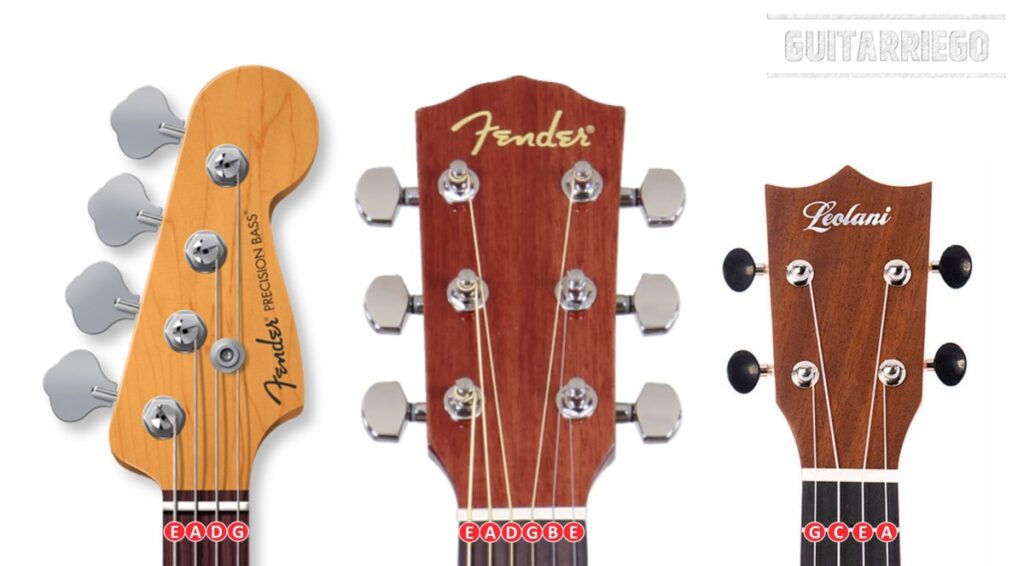
This is because the bass is tuned to the same intervals as strings 3, 4, 5, and 6 of the guitar, while the ukulele is tuned to the same intervals as strings 1, 2, 3, and 4 of the guitar.
So if you take the guitar and put a capo on the fourth fret and exclude the fifth and sixth strings you will get the ukulele tuning but linear, like you would have a Low G instead the traditional High G.

In this way, you can find that the ukulele chords are the same as the guitar, excluding strings 5 and 6, and transposing the capo to the fourth fret. Thus, you find that the C chord on the ukulele is the same structure as the open G chord on the guitar without the 5th and 6th string, the G chord on the ukulele is the structure of the open D chord on the guitar, and so on.
The most popular Ukulele chords
As we have already seen, some of the most popular ukulele chords are among the easiest to learn and play, such as C, F, Am, and G. So, if you are a beginner, we recommend that you start with these four basic ukulele chords, and then continue with the rest like D, E, A, B and others to play your favorite songs.
With these easy ukulele chords you will be able to play the best easy ukulele songs for beginners like “Over The Rainbow” by Israel Kamakawiwo’ole, “Hey Soul Sister” by Train and “Vance Joy” by Riptide and many more. So, check out some of the most popular beginner ukulele chords below.
C Major Chord for Ukulele
Composed of the notes C, E, and G, the C major chord is the easiest to play and the perfect starting point for learning all ukulele chords. Furthermore, this chord forms the basis of a wide variety of songs from all genres.

A minor (Am) chord for ukulele
Composed of the notes A, C, and E, the A minor ukulele chord is another of the super simple chords, since it only uses a single finger. This, also part of the C major scale, and is the relative minor of C, is a super used ukulele chord in easy songs for beginners.

The Ukulele Am chord can be played with finger 1 or 2. We recommend finger 2, since just by placing finger 1 on string 2, fret 1, you play the F chord, or finger 1 on string 3, fret 1 and play the A chord.
F Major chord for ukulele
The F major chord consists of the notes F, A and C. The F major is the 4th degree of the C scale, so it is another chord widely used for songs that are in C, in addition to A sharp (A#) scale. This chord is very easy to play, if you already master the Am chord, just by adding finger 1 on string 2, fret 1, you already have the F chord.

G Major Ukulele Chord
The G major chord is made up of the notes G, B, and D, and is the fifth degree of the C scale and the fourth degree of the D scale. Thus, the G ukulele chord will be used whether the song is in the G, C and D scale. This is the most complex chord we’ve seen so far, since it uses 3 fingers.

You may also be interested in How to Write a Song From Lyrics to Music.
D Major Ukulele Chord
The D major chord is made up of the notes D, F sharp (F#) and A. The D is the fifth degree of the G scale and the fourth degree of the A scale. Thus, the D ukulele chord will be used whether the song is in the D, G or A scale. Strum this bright-sounding chord.
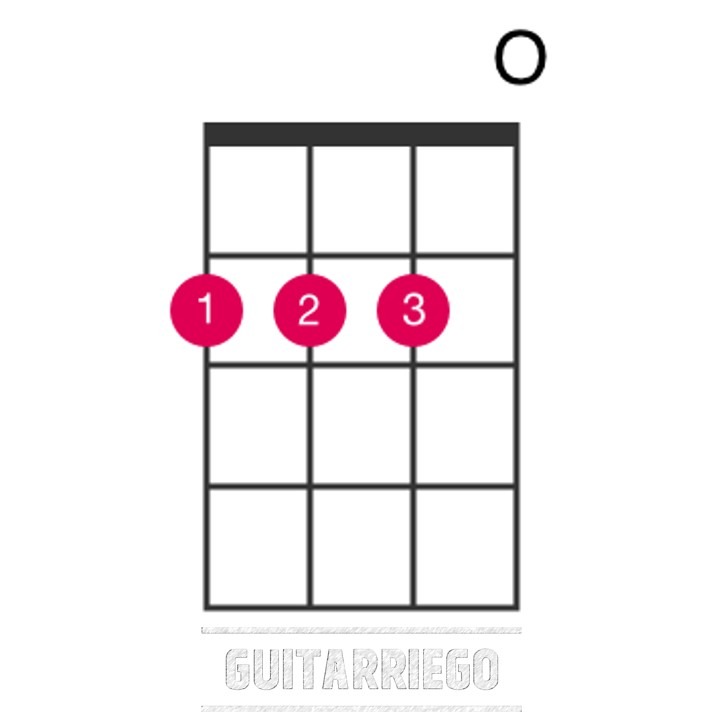
The D major chord can be done using just the 1st finger making a barre, but the drawback of this technique is that it is easy to brush the 1th string and have it not ring properly. Therefore, we recommend that you use three fingers, 1, 2 and 3, as shown in the D ukulele chord chart above.
A Major Ukulele Chord
The A major chord is made up of the notes A, C sharp (C#), and E. The A major chord is the fifth degree of the D scale, and the fourth degree of the E scale. Therefore, the A chord of the ukulele is played in songs that are the A, D or E scale. Also, it’s a great easy chord for beginning ukulele players to learn.

If you already master the F major chord, this chord will be very easy since you only have to raise finger 1 from string 2 to string 3, always on fret 1. The same, if you already master the A minor chord since you just have to add finger 1 on string 3, fret 1.
E minor (Em) chord for ukulele
The E minor ukulele chord is made up of the notes E, G, and B. The E minor chord is the third degree of the C major scale and the sixth degree of G major. So the Em ukulele chord will be used whether the song is in the Em, C or G scale. It forms the basis of a variety of songs from all genres. Learn the E minor chord.

C7 Ukulele Chord
As we’ve already seen, seventh chords take the standard formula for a chord and add an extra note: the minor seventh note of the scale. The C7 is a dominant seventh chord and contains the notes C, E, G and A#. The C7 chords generates a tension that calls for resolution in another chord. Thus, a C7 will normally resolve to an F, as in the song “Have You Ever Seen The Rain?” by Creedence Clearwater Revival.
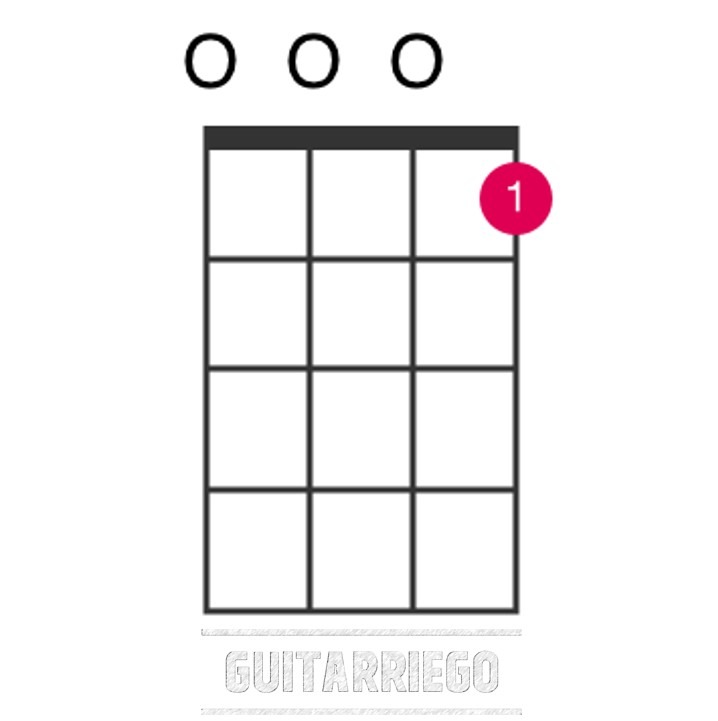
We also recommend that you visit our guide on the best mobile apps to learn ukulele, guitar or bass for beginners.
B minor (Bm) chord for Ukulele
The Bm ukulele chord is made up of the notes B, D, and F#. Minor chords give the music a downbeat tone, bringing down the ukulele’s upbeat spirit. This chord is a little more complex since it requires the use of the barre with finger 1. Thus, the Bm uke chord will require more patience and learning time for any beginning ukulele player.

In the Bm ukulele chord diagram it is marked that the barre reaches strings 1, 2 and 3, but not the fourth string. But we recommend that the barre goes all the way up the fingerboard and also include string 4, which will sound on the B on fret 4 anyway. Thus, finger 3 is more comfortable to play string 4, as seen below.

E Major Chord for Ukulele
The E major chord is composed of the notes E, G# and B. The E major chord is the fifth degree of the A scale and the fourth degree of the B scale. Thus, this chord is part of a large variety of songs of all musical genres that are in the scale of E, A and B.

F minor chord for ukulele
The F minor chord consists of the notes F, A flat (Ab) and C. This ukulele chord has a sad sound. You will need fingers 1, 2 and 3, with some separation, which does not make it one of the easiest chords. But it’s not too complex a chord for a ukulele beginner either.
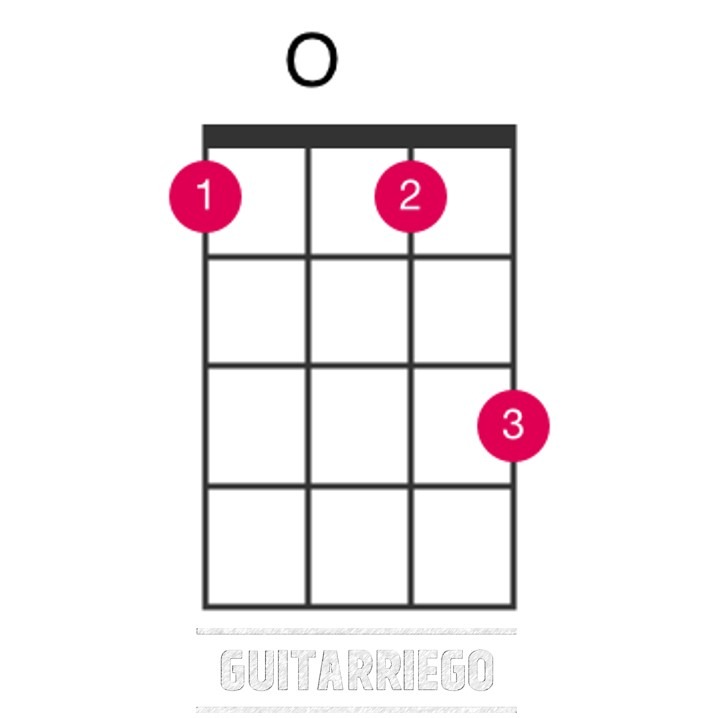
C minor (Cm) chord for Ukulele
The C minor chord is made up of the notes C, E flat (Eb), and G. You can play it using fingers 1, 2, and 3, which is the easiest way. But you also have the alternative of using fingers 2, 3 and 4, leaving finger 1 free.
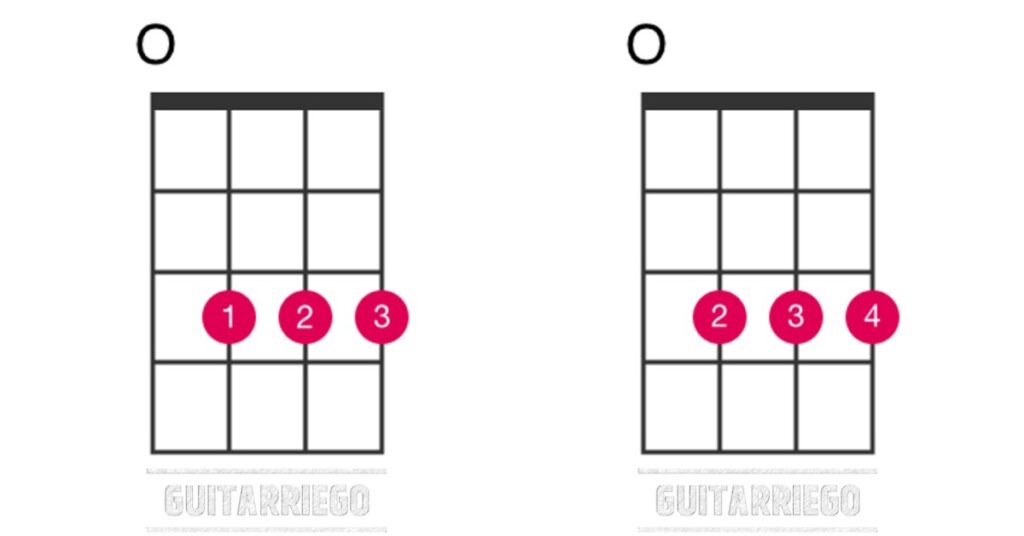
You may also be interested in buying a cheap acoustic guitar for beginners.
E7 Ukulele Chord
As we’ve already seen, dominant seventh chords take the standard formula for a major chord and add an additional note: the minor seventh. Thus, the E7 uke chord contains the notes E, G#, B and D.
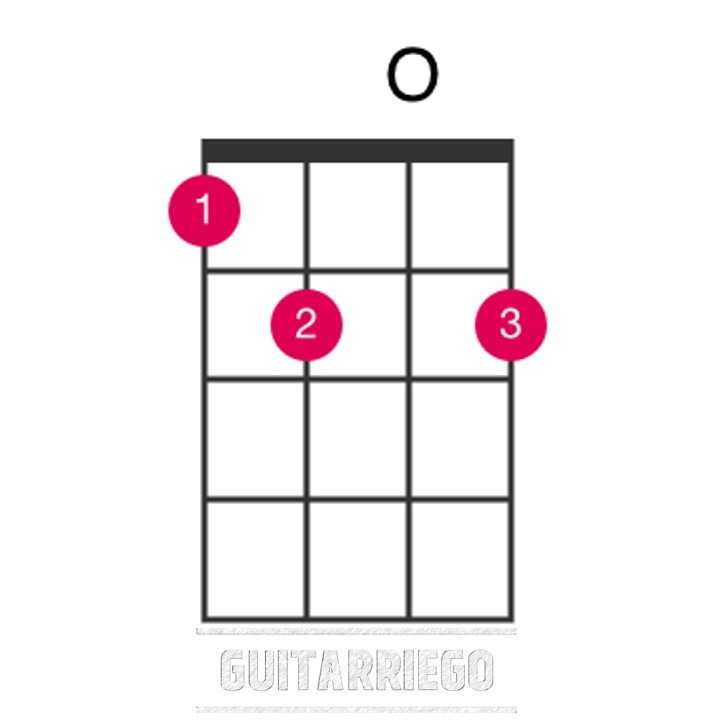
D minor Ukulele Chord (Dm)
Dm chord for Uke is made up of the notes D, F, and A. The D minor chord can be heard in a variety of different songs, as it is a chord of the C, F scale, among other widely used scales. Learn to play the D minor chord with patience and time.

Also, to help you in this learning process, we leave you this great tutorial from our friend Brett from Ukulele Tricks:
The best thing about learning ukulele chords for beginners
The best part of learning ukulele chords is playing them on some of your favorite songs. Chances are some of your favorite songs are pretty easy to play. Take a look at some of our picks for the best easy ukulele songs for beginners.
More Ukulele Chords
Of course, the ukulele chords that we see here are the most common and basic ones that you will need to learn most songs. Therefore, we leave you a chart with all the chords you might need at some point.
The ukulele chords included here are:
- Major chords: C, D, E, F, G, A, B
- Minor chords: Cm, Dm, Em, Fm, Gm, Am, Bm
- Dominant seventh chords: C7, D7, E7, F7, G7, A7, B7
- Major seventh chords: Cmaj7, Dmaj7, Emaj7, Fmaj7, Gmaj7, Amaj7, Bmaj7
- Minor seventh chords: Cm7, Dm7, Em7, Fm7, Gm7, Am7, Bm7

Final Thoughts on Ukulele Chords
Ukulele chords are the structures with which you can play your favorite songs by your idols, and maybe even your own songs one day. If you are new to plucked musical instruments, it will be quite difficult at first, but over time, you will see how easy these ukulele chords become. If you are a guitarist, it will be very easy for you to master the ukulele, given its size and fewer strings. Be consistent in your practice and you will soon master ukulele chords and enjoy playing great songs.
If you have any questions or want to know about other ukulele chords, do not hesitate to write us below, in the comments section.
Also, learn how to read sheet music and music with our tutorial.






